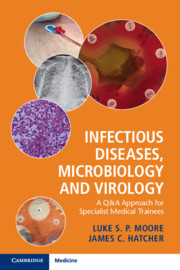Book contents
- Infectious Diseases, Microbiology and Virology
- Infectious Diseases, Microbiology and Virology
- Copyright page
- Contents
- Preface
- Reference Ranges
- Abbreviations
- Chapter 1 Biology of Bacteria, Viruses, Fungi and Parasites and the Host–Pathogen Interactions
- Chapter 2 Microbiology and Virology Laboratory Practice
- Chapter 3 Health and Safety for Infectious Diseases, Microbiology and Virology
- Chapter 4 Principles of Public Health in Relation to Infectious Diseases, Microbiology and Virology
- Chapter 5 Infection Prevention and Control
- Chapter 6 Important Clinical Syndromes Presenting from the Community and within Healthcare Organisations
- Chapter 7 Understanding the Use of Antimicrobial Agents
- Chapter 8 Vaccination
- Chapter 9 The Management of HIV Infection, Opportunistic Infections and Complications of Other Causes of Immunocompromise
- Chapter 10 Travel and Geographical Health; Imported Infection and the Provision of Pre-travel Health Advice
- Index
- References
Chapter 5 - Infection Prevention and Control
Published online by Cambridge University Press: 19 December 2019
- Infectious Diseases, Microbiology and Virology
- Infectious Diseases, Microbiology and Virology
- Copyright page
- Contents
- Preface
- Reference Ranges
- Abbreviations
- Chapter 1 Biology of Bacteria, Viruses, Fungi and Parasites and the Host–Pathogen Interactions
- Chapter 2 Microbiology and Virology Laboratory Practice
- Chapter 3 Health and Safety for Infectious Diseases, Microbiology and Virology
- Chapter 4 Principles of Public Health in Relation to Infectious Diseases, Microbiology and Virology
- Chapter 5 Infection Prevention and Control
- Chapter 6 Important Clinical Syndromes Presenting from the Community and within Healthcare Organisations
- Chapter 7 Understanding the Use of Antimicrobial Agents
- Chapter 8 Vaccination
- Chapter 9 The Management of HIV Infection, Opportunistic Infections and Complications of Other Causes of Immunocompromise
- Chapter 10 Travel and Geographical Health; Imported Infection and the Provision of Pre-travel Health Advice
- Index
- References
Summary
Limiting the spread of communicable diseases within a healthcare setting is integral to patient safety and clinical practice. Practitioners in infectious diseases, microbiology and virology often lead infection prevention and control teams, and are often responsible for creating and implementing policies and ensuring their effectiveness. They are also often responsible for investigating outbreaks when there are lapses in practice, or other causes for onwards transmission of infectious agents.
- Type
- Chapter
- Information
- Infectious Diseases, Microbiology and VirologyA Q&A Approach for Specialist Medical Trainees, pp. 79 - 95Publisher: Cambridge University PressPrint publication year: 2019



